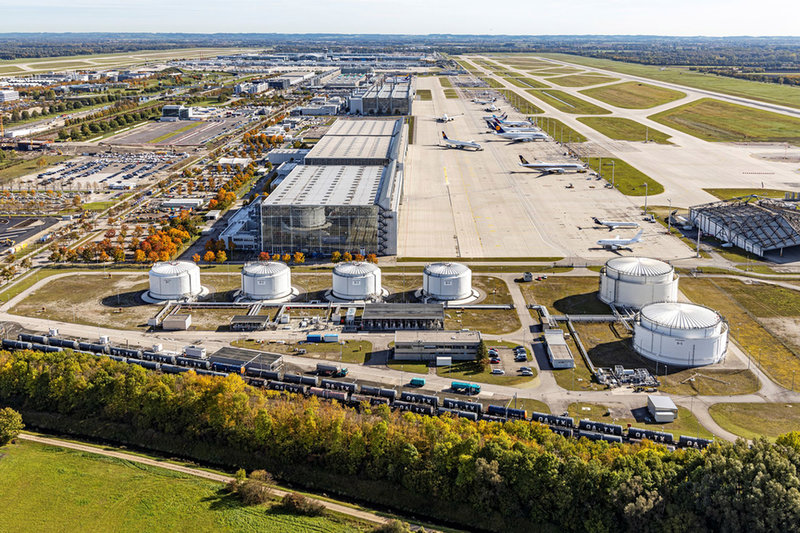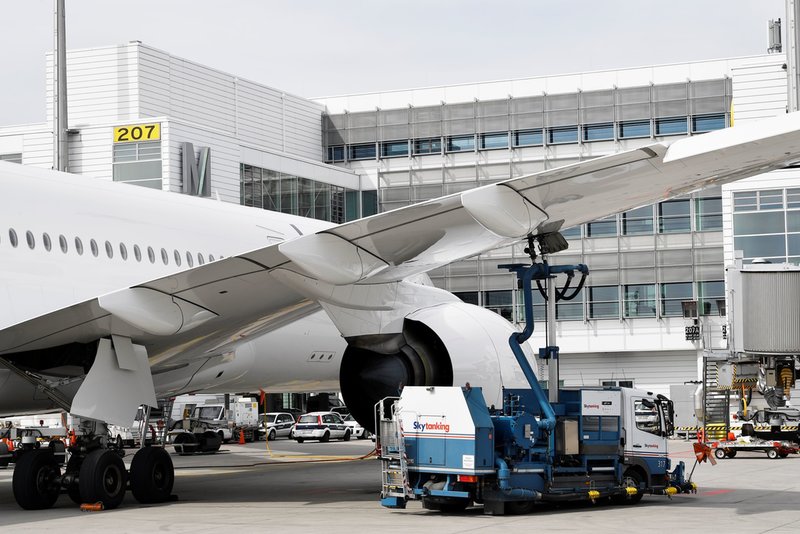Fuel
Sustainable aviation fuel: working towards a greener future
To combat aviation pollution, Munich Airport has recently launched refuelling with green kerosene. Frankie Youd finds out about the projects and the benefits of this fuel for aviation.
Image: copyright
According to data provided by Air Transport Action Group, flights produced 915 million tonnes of CO2 worldwide in 2019, with the aviation industry being responsible for 12% of CO2 emissions globally.
The introduction of sustainable aviation fuels (SAF) at airports is hoped to be a key step forward for the industry on its decarbonisation journey. Air Transport Action Group states that alternative fuels – sustainable aviation fuels in particular – can help achieve the industry reach its climate goals.
SAF sourced from algae or water-based by-products have been shown to significantly reduce the carbon footprint of aviation fuel by up to 80% over their lifecycle.
Munich Airport takes a step towards greener aviation
Munich Airport, the second busiest airport in Germany in terms of passenger traffic and the ninth busiest airport in Europe, handling 47.9 million passengers in 2019, is pioneering the use of SAF.
Under a recently launched initiative, the airport is providing green kerosene as an alternative aircraft fuel. Its onsite tank facility holds 42,200 cubic metres of fuel, which is being delivered by various oil companies on behalf of airlines.
Once delivered, the fuel is fed into the airport’s fuel depot which is connected to a 17km underground pipeline system, which leads to the aircraft parking locations. The operator of the airport’s tank farm ensures quality control of the fuels delivered to make sure they are in accordance with Jet A1 aviation fuel requirements.
Planning for the introduction of SAF at the airport began in early summer 2020; by late summer the airport began inspecting the technical requirements needed for the fuel’s inclusion.
The introduction of sustainable aviation fuel is an important milestone on the way to CO2-neutral flying.
“The introduction of SAF is an important, forward-looking contribution to achieving our ambitious climate targets,” says Andreas Koennecke, vice president for aviation properties at Munich Airport.
“The officially declared goal is to operate Munich Airport in a CO2 neutral manner by 2030 at the latest – investing €150m in climate protection measures. However, Munich Airport's long-term target is to completely reduce all CO2 emissions to ‘net zero carbon’ by 2050.”
The SAF fuels used today are predominantly produced from renewable raw materials including vegetable oils and fats, also known as biomass-to-liquid’ fuels. However, according to the airport, future fuels could also be created from synthetically produced paraffin, known as power-to-liquid fuels which are produced via electrolysis of water, CO2 and renewable energy.
The introduction of SAF fuels, which have a lower emission impact compared to traditional kerosene, marks an important step towards the airport’s reduction of its carbon footprint.
“The introduction of SAF is an important milestone on the way to CO2-neutral flying,” Koennecke says. “The use will make aviation more sustainable. By approving our refuelling facilities for sustainable aviation fuel, we are enabling airlines to reduce their CO2 emissions on flights from Munich by using SAF.
“These ‘green fuels’ will have a key role to play in the decarbonisation of air transport. We expect the share of SAF in aviation to increase continuously in the coming years.”

The tank farm at Munich Airport, where aviation fuels are stored.
Flying through greener skies
The introduction of SAF at Munich is a milestone not just for the airport but also the industry as a whole, with the hope that many more airports across the globe follow suit. Alongside reducing greenhouse gas emissions, SAFs also reduce the number of harmful particulates that are produced such as SOx and NOx emissions.
“Sustainable aviation fuels are an opportunity for the future of air transport. The goal must be to create incentives for airlines to use SAF and thus increase more demand in aviation in the medium term.” Koennecke says. “Governments have to help set the course for an increased production of these ‘green fuels’, and last but not least, the production and purchasing costs for SAF need to become more attractive.”
The only way for aviation to continue growing sustainably is for it to stop burning kerosene.
Jo Dardenne, aviation manager for Transport and Environment – a European collection of non-governmental organisations working within the transport and environment sector that promotes sustainable transport within Europe – says the introduction of SAF is a step in the right direction.
“The only way for aviation to continue growing sustainably is for it to stop burning kerosene,” she says. “That’s why SAFs and specifically synthetic kerosene play an essential role in helping the sector decarbonise. Synthetic kerosene is a carbon-neutral fuel as it is created from renewable hydrogen and CO2 taken from the air, which means when it burns it only releases CO2 that it took initially from the atmosphere.
“This is especially important to address the impact of those long-haul flights that are responsible for the biggest chunk of the sector’s emissions.”

Refuelling in progress at Munich Airport.
What more can be done?
With the industry committing to a reduction of net aviation carbon emissions to 50% below 2005 levels by 2050, what other steps does the industry need to take to ensure this can be achieved?
“The aviation industry has been overly subsidised and under-regulated over the past decades, which is why emissions soared right up until the start of the Covid-19 crisis,” Dardenne says. “Since 2013, aviation emissions had increased by 27.6% and are projected to double or triple by 2050.
“It’s no longer politically and environmentally acceptable for a sector like aviation to escape its climate responsibilities when all other sectors of the economy, like the industry or the power sector, are asked to reduce their environmental impact.
“All actors have a great role to play in decarbonising the sector, from airports deploying infrastructure for alternative fuels to airspace managers improving flight efficiency, or aircraft manufacturers developing zero-emissions planes, and airlines using increasing amounts of clean fuels. But this won’t happen without effective regulation. The faster the policies are implemented, the better it is for the aviation sector and the climate.”
Climate change is high on the agenda for governments worldwide, and airports and the wider aviation sector adopting greener fuels is a significant step towards a greener, more environmentally conscious future.
Main image: Munich Airport is Germany’s second-busiest airport.